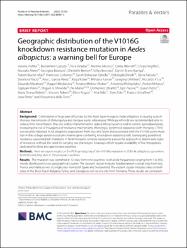Geographic distribution of the V1016G knockdown resistance mutation in Aedes albopictus: a warning bell for Europe

Göster/
Erişim
info:eu-repo/semantics/openAccessTarih
2022Yazar
Pichler, VerenaCaputo, Beniamino
Valadas, Vera
Micocci, Martina
Horvath, Cintia
Virgillito, Chiara
Akıner, Muhammet Mustafa
Balatsos, Georgios
Bender, Christelle
Besnard, Gilles
Bravo-Barriga, Daniel
Bueno-Mari, Ruben
Collantes, Francisco
Delacour-Estrella, Sarah
Dikolli, Enkelejda
Falcuta, Elena
Flacio, Eleonora
Garcia-Perez, Ana L.
Kalan, Katja
Kavran, Mihaela
Lia, Riccardo P.
Marabuto, Eduardo
Medialdea, Raquel
Melero-Alcibar, Rosario
Michaelakis, Antonios
Mihalca, Andrei
Mikov, Ognyan
Miranda, Miguel A.
Muller, Pie
Otranto, Domenico
Pajovic, Igor
Petric, Dusan
Rebelo, Maria Teresa
Robert, Vincent
Rogozi, Elton
Tello, Ana
Zitko, Toni
Schaffner, Francis
Pinto, Joao
Della Torre, Alessandra
Üst veri
Tüm öğe kaydını gösterKünye
Pichler, V., Caputo, B., Valadas, V., Micocci, M., Horvath, C., Virgillito, C., Akiner, M., Balatsos, G., Bender, C., Besnard, G., Bravo-Barriga, D., Bueno-Mari, R., Collantes, F., Delacour-Estrella, S., Dikolli, E., Falcuta, E., Flacio, E., García-Pérez, A. L., Kalan, K., Kavran, M., … Della Torre, A. (2022). Geographic distribution of the V1016G knockdown resistance mutation in Aedes albopictus: a warning bell for Europe. Parasites & vectors, 15(1), 280. https://doi.org/10.1186/s13071-022-05407-3Özet
Background: Colonization of large part of Europe by the Asian tiger mosquito Aedes albopictus is causing autochthonous transmission of chikungunya and dengue exotic arboviruses. While pyrethroids are recommended only to reduce/limit transmission, they are widely implemented to reduce biting nuisance and to control agricultural pests, increasing the risk of insurgence of resistance mechanisms. Worryingly, pyrethroid resistance (with mortality < 70%) was recently reported in Ae. albopictus populations from Italy and Spain and associated with the V1016G point mutation in the voltage-sensitive sodium channel gene conferring knockdown resistance (kdr). Genotyping pyrethroid resistance-associated kdr mutations in field mosquito samples represents a powerful approach to detect early signs of resistance without the need for carrying out phenotypic bioassays which require availability of live mosquitoes, dedicated facilities and appropriate expertise.
Methods: Here we report results on the PCR-genotyping of the V1016G mutation in 2530 Ae. albopictus specimens from 69 sampling sites in 19 European countries.
Results: The mutation was identified in 12 sites from nine countries (with allele frequencies ranging from 1 to 8%), mostly distributed in two geographical clusters. The western cluster includes Mediterranean coastal sites from Italy, France and Malta as well as single sites from both Spain and Switzerland. The eastern cluster includes sites on both sides of the Black Sea in Bulgaria, Turkey and Georgia as well as one site from Romania. These results are consistent with genomic data showing high connectivity and close genetic relationship among West European populations and a major barrier to gene flow between West European and Balkan populations.
Conclusions: The results of this first effort to map kdr mutations in Ae. albopictus on a continental scale show a widespread presence of the V1016G allele in Europe, although at lower frequencies than those previously reported from Italy. This represents a wake-up call for mosquito surveillance programs in Europe to include PCR-genotyping of pyrethroid resistance alleles, as well as phenotypic resistance assessments, in their routine activities.

















